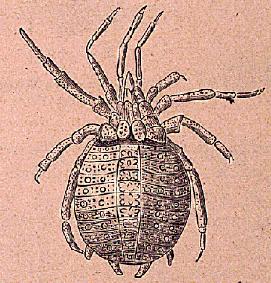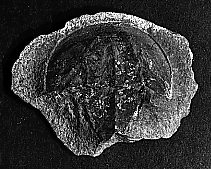



Cheliceramorpha: Fossil Record






The oldest certain chelicerate currently known is Sanctacaris from the Middle Cambrian Burgess Shale of British Columbia. Although it lacks the chelae, or claws, which give the group its name, it does show the same pattern of tagmosis (clustering and specialization of segments) that characterizes all chelicerates. A number of other fossils from the Burgess Shale seem to be closer to the living chelicerates than to any other group; for the purposes of this exhibit, these are grouped in the Cheliceramorpha. Fossil aglaspids are known from the Lower Cambrian through Ordovician, but the aglaspids are problematic forms that may not belong with the chelicerates.
Of the two major lineages of marine chelicerates, the Eurypterida (sea scorpions) appeared in the Ordovician and lasted until the Permian, while the Xiphosura (horseshoe crabs) appeared in the Ordovician and are still with us today. The fossil shown below, Palaeolimulus from the Pennsylvanian, looks very much like living horseshoe crabs.

By the Silurian, true scorpions had evolved; almost all of the Paleozoic scorpions known, however, were aquatic. The oldest fossil land arachnid currently known is Late Silurian in age, 414 million years old; it's a trigonotarbid, an extinct form that superficially resembles a spider. A growing number of Devonian fossils of mites, spiders, and others show that arachnids made the transition to land life, and began to radiate, at about the same time that the uniramians (insects, centipedes, millipedes, and their relatives) did. The fossil record of land chelicerates is sparse, but nearly all terrestrial lineages had evolved by the Pennsylvanian, including the land scorpions, spiders, whip-scorpions, daddy-longlegs, and a number of extinct groups - like the trigonotarbids, represented by Eophrynus prestvici from England, depicted above.
Fossil land chelicerates are extremely rare in the Mesozoic, but the picture improves in the Tertiary, when deposits of amber trapped many arthropods. Most terrestrial arthropods live in habitats such as deserts or forests, in which fossilization may be a rare event; many are also relatively small and delicate organisms.
Petrunkevitch, A. 1960. Arachnida. P42-P162 in Moore, R.C. (ed.) Treatise on Invertebrate Paleontology. Part P: Arthropoda 2: Chelicerata. Geological Society of America and University of Kansas Press, Lawrence, Kansas.
Wills, M. A., D. E. G. Briggs, and R. A. Fortey. 1994. Disparity as an evolutionary index: a comparison of Cambrian and Recent arthropods. Paleobiology 20(2): 93-130.


